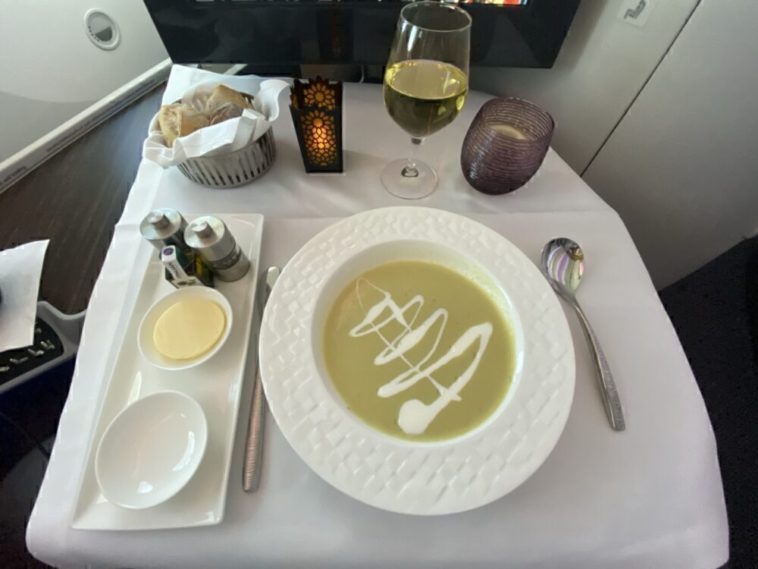How Food Is Cooked On An Aircraft? – Simple Flying
Love it or hate it, we have all had plenty of meals onboard aircraft. While the quality varies massively between airlines and cabin classes, handling and cooking are very similar. This article takes a look at how food is prepared on aircraft.

Preparation on the ground
It probably comes as no surprise that most of the preparation of airline meals takes place before the flight, on the ground. Airlines will either prepare their own meals or, more commonly, contract with a manufacturer to supply them.
This of course varies between countries, with many different companies offering such services. One of the largest is LSG Sky Chefs, and this article by the Airline Passenger Experience Association (APEX) sheds some light on their scale. They explain how the Frankfurt location alone, which caters to several airlines, produces 85,500 meals each day. It also operates the largest dishwashing facility in Europe – serving equipment is reused, but all food items that are not used are disposed of.

Airline food is designed to be reheated. These on the ground facilities will prepare, cook, and package large quantities of meals. Depending on the type of food, after cooking it will either be chilled or frozen until it is reheated onboard (usually within ten hours of preparation). A lot of food, including most meats, are carefully partially cooked. The reheating process will then take over the final part of the cooking.
There have of course been some changes in 2020, but the principles still remain the same. Many airlines have, hopefully for a temporary period, shifted to simpler menus and fewer items.
Loading onboard
Once prepared, usually at an on-airport site or certainly close by, the chilled food is loaded onto the aircraft. This sounds simple, but it is a huge logistical challenge. With thousands of meals across hundreds of flights, all needed to be loaded timely in a short turnaround, you can imagine the challenges!

Re-heating during the flight
Once onboard the chilled food needs to be heated using the aircraft ovens. Each type of dish will have instructions for its re-heating and preparation. For most economy meals, reheating simply takes places in the provided tray. For more luxurious premium cabin meals, they will often be reheated in a provided tray and then transferred to other dishes for serving.
The ovens on an aircraft are specialized convection ovens with food heating using hot air. Microwaves are not used (although some early 747s did have them onboard). The meals are loaded on trays into the oven. Most meals take around 20 minutes to heat, and of course, they are heated and served in batches.

On board chefs
Several airlines market onboard chefs for their business or first-class cabins. While you may think that there is a kitchen onboard where they cam prepare fresh meals, this is unfortunately not the case (as this post by blog One Mile At A Time discusses). Chefs (usually specially trained flight attendants), will prepare meals using the same ovens, but with a wider choice of ingredients and options. Some airlines offer fresh eggs cooked onboard, but that is about as far as it goes!

Bland tasting food?
Many passengers complain about airline food tasting too plain and bland. This is only partly true. While it makes sense to avoid overly strong or spicy flavors out of the need to cater to all passengers, there is also influence from the cabin atmosphere. With the pressurized cabin and the low humidity, perception of taste, and salt and sweetness, can diminish significantly
Maintaining moisture is a key concern with airline meals. In the low humidity cabin environment, it can easily dry out. Food will be designed (and tested) with this in mind, and modern aircraft convection ovens help to maintain moisture.
And what about leftover food?
And as a final thought, have you ever wondered what happens to unused airline food? According to IATA research, 1.14 million tonnes of food was wasted from in-flight catering in 2017.

Simple Flying took a detailed look at the current problem and work to resolve this in a recent article. The default option remains, sadly, sending leftovers to landfill. But many countries and airlines are engaging in programs to recycle or donate reusable food items. And there is also more work being done to better predict usage (or simply ask passengers beforehand) and optimize loading.
Would you like to share any thoughts on airline food and preparation? Do you know of any airlines that prepare things slightly differently? Or examples of airlines that do it especially well, or badly? Let us know in the comments.
Published at Wed, 03 Feb 2021 03:00:45 +0000





Comments
Loading…